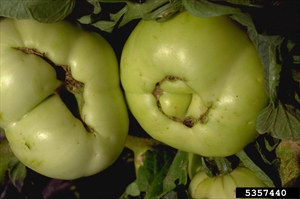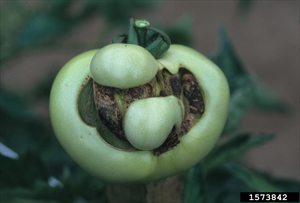- Worldwide. Physiological disorder common wherever tomatoes are grown. A general term for lumps, outgrowths, holes and scar tissue on fruits. The fruits ase still edible; they are just unsightly, and unsaleable.
- Varieties differ in susceptibility, with those producing larger fruit more likely to show symptoms.
- Cause not understood. Several suggestions: initial dry period then long period of rain; alternating dry and wet soils; cold temperatures (<10°C) at night during flowering; large fluctuations in day and night temperatures; excessive N; thrips damaging female parts of flower; excessive pruning indeterminate varieties (lowering auxin concentrations); use of 2,4-D herbicide.
- Cultural control: avoid excessive pruning; do not apply excessive N; avoid planting in seasons when low temperature (<10°C) expected; avoid extremes of wet and dry; use varieties that are less susceptible; use a mulch.
Pacific Pests, Pathogens, Weeds & Pesticides - Online edition
Pacific Pests, Pathogens, Weeds & Pesticides
Tomato catface (420)
Tomato catface
None; a physiological disorder.
AUTHOR Grahame Jackson
Information from tomato, cat facing. University of Massachusetts Amherst. (https://ag.umass.edu/vegetable/fact-sheets/tomato-cat-facing); and from Tomato diseases (undated) Catface. UF/IFAS. University of Florida. Photo 1. Union Square Green Market (https://www.instagram.com/p/BIVuBCKhuDf/?utm_source=ig_embed). Photos 2,4&5 Gerald Holmes, California Polytechnic State University at San Luis Obispo. Photo 3 M.E. Bartolo, Bugwood.org.
Produced with support from the Australian Centre for International Agricultural Research under project HORT/2016/185: Responding to emerging pest and disease threats to horticulture in the Pacific islands, implemented by the University of Queensland and the Secretariat of the Pacific Community.








